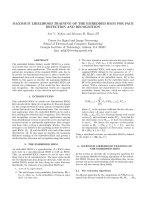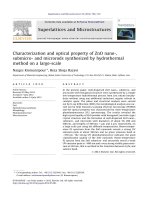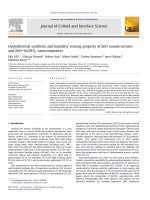Synthesis and functionalization of micro nano particles for malicious cells detection and elimination
Bạn đang xem bản rút gọn của tài liệu. Xem và tải ngay bản đầy đủ của tài liệu tại đây (2.78 MB, 193 trang )
SYNTHESIS AND FUNCTIONALIZATION OF
MICRO/NANO-PARTICLES FOR MALIGNANT
CELLS DETECTION AND ELIMINATION
HU FEIXIONG
NATIONAL UNIVERSITY OF SINGAPORE
2009
SYNTHESIS AND FUNCTIONALIZATION OF
MICRO/NANO-PARTICLES FOR MALIGNANT
CELLS DETECTION AND ELIMINATION
HU FEIXIONG
(B. E., M. S., Tianjin University)
A THESIS SUBMITTED FOR
THE DEGREE OF DOCTOR OF PHILOSOPHY
DEPARTMENT OF CHEMICAL AND BIOMOLECULAR
ENGINEERING
NATIONAL UNIVERSITY OF SINGAPORE
2009
i
ACKNOWLEDGEMENTS
First of all, I would like to express my deepest gratutide to my supervisors,
Professor Neoh Koon Gee and Professor Kang En-Tang, who have been
instrumental in guiding this research and providing useful advice throughout the long
period of this research work. I would like to thank them for their patience and
unfaltering commitment to their students; for their inspired ideas, which always make
me go ahead on my way. Their enthusiasm, sincerity and dedication to scientific
research have greatly impressed me and will benefit me in my future career.
I would like to thank all my friends and all group members for their valuable
helps in both academic issues and in other issues. Particular thanks go to Dr. Cen Lian,
Dr. Li Yali and Dr. Shi Zhilong for sharing with me their invaluable experience in the
research field. In addition, I have many thanks to give to all technologists, specifically
Miss Chew Su Mei and Mr Yuan Zeliang, thanks for kindly help during my research.
The financial support for Ph.D study from National University of Singapore is also
greatly appreciated.
Finally, I would like to express my deepest gratitude and indubtedness to my
parents, my grandfather and other relatives for their constant concern love, patience
and surpport. Special thanks to my wife, Ma Lanfang, for her love and encouragement.
ii
TABLE OF CONTENTS
ACKNOWLEDGEMENTS i
TABLE OF CONTENTS ii
SUMMARY vi
NOMENCLATURE viii
LIST OF FIGURES ix
LIST OF TABLES xiii
CHAPTER 1 INTRODUCTION 1
CHAPTER 2 LITERATURE SURVEY 6
2.1 Effects of Biocides on Bacteria 7
2.1.1 Potential Targets and Effects of Biocides 7
2.1.2 Interactions between Cell Membrane and Disinfectants 8
2.1.3 Mechanisms of Antibacterial Action of Quaternary Ammonium Salts.9
2.1.4 Factors Affecting Biocidal Activity 10
2.1.4.1 Electrostatic Interaction between the Cells and the Disinfectants
10
2.1.4.2 Hydrophobic Chain Length 11
2.1.4.3 Morphological Effect of Disinfectants 12
2.2 Magnetic Nanoparticles for Cancer Detection and Treatment 14
2.2.1 Basic Concepts of Magnetism 15
2.2.2 Synthesis Methods of Magnetic Nanoparticles 17
2.2.2.1 Precipitation 18
2.2.2.2 Microemulsions 20
2.2.2.3 Polyols 21
2.2.2.4 High-temperature Decomposition of Organic Precursors 24
2.2.3 Functionalization Magnetic Nanoparticles for Biomedical Applications
25
2.2.3.1 Coprecipitation 25
2.2.3.2 Encapsulation Method 26
2.2.3.3 Deposition Methods 27
2.2.3.4 Surface Initiated Polymerization Processes 29
2.2.4 Magnetic Nanoparticles for Biomedical Applications 30
iii
2.2.4.1 Magnetic Targeted Drug Delivery 30
2.2.4.2 Contrast Agents for Magnetic Resonance Imaging 33
2.2.4.3 Magnetically Induced Hyperthermia Treatment for Malignant
Cells 36
CHAPTER 3 ANTIBACTERIAL AND ANTIFUNGAL EFFICACY OF
SURFACE FUNCTIONALIZED POLYMERIC BEADS IN REPEATED
APPLICATIONS 38
3.1 Introduction 39
3.2 Materials and Methods 42
3.2.1 Materials 42
3.2.2 Preparation of Microbeads 42
3.2.3 Quaternization of the P4VP 42
3.2.4 Bulk and Surface Analysis 43
3.2.5 Antibacterial Assay on E. coli 44
3.2.6 Antifungal Assay on A. niger 46
3.3 Results and Discussion 49
3.3.1 Properties of Microbeads 49
3.3.2 Antibacterial Characteristics of Beads 54
3.3.3 Antifungal Characteristics of Beads 61
3.4 Conclusions 68
CHAPTER 4 SYNTHESIS AND IN VITRO ANTI-TUMORAL
EVALUATION OF TAMOXIFEN-LOADED MAGNETITE/PLLA
COMPOSITE NANOPARTICLES 69
4.1 Introduction 70
4.2 Materials and Methods 73
4.2.1 Materials 73
4.2.2 Preparation of Magnetic Nanoparticles 73
4.2.3 Preparation of Tamoxifen-loaded Magnetite/PLLA Composite
Nanoparticles (TMCN) 74
4.2.4 Characterization of the Magnetic Carrier 75
4.2.4.1 Particle Size and Surface Properties 75
4.2.4.2 Fe
3
O
4
Loading and Tamoxifen Encapsulation Efficiencies 75
4.2.5 In vitro Tamoxifen Release Studies 76
4.2.6 Cell Culture Assay 77
iv
4.2.6.1 Nanoparticle Uptake by MCF-7 Cells 77
4.2.6.2 Inhibition of MCF-7 Cells Proliferation 77
4.3 Results and Discussion 79
4.3.1 Characterization of the Magnetic Carrier 79
4.3.1.1 Fe
3
O
4
Loading and Distribution 79
4.3.1.2 Drug Loading and in vitro Release 83
4.3.1.3 Particle Size, Morphology and Surface Properties 85
4.3.2 Cell Culture Assay 89
4.3.2.1 Cell Uptake of TMCN 89
4.3.2.2 Cytotoxicity of TMCN against MCF-7 Cells 92
4.4 Conclusions 95
CHAPTER 5 SYNTHESIS OF FOLIC ACID FUNCTIONALIZED PLLA-
b-PPEGMA POLYMERIC NANOPARTICLES FOR CANCER CELL
TARGETING 96
5.1 Introduction 97
5.2 Materials and Methods 100
5.2.1 Materials 100
5.2.2 Preparation of Double-headed Initiator 100
5.2.3 Preparation of PLLA-b-PPEGMA 101
5.2.3.1 2-bromo-2-methylpropionyl End Functionalized Poly(L-lactic
acid) 101
5.2.3.2 ATRP of PEGMA 101
5.2.3.3 Conversion of the Terminal Hydroxyl Groups to Chloride 102
5.2.4 Preparation of Folic Acid Functionalized PLLA-b-PPEGMA
Polymeric Nanoparticles (PNP) with Encapsulated Magnetic
Nanoparticles 103
5.2.4.1 PNP with Encapsulated Magnetic Nanoparticles 103
5.2.4.2 PNP Surface Functionalized with Folic Acid 104
5.2.5 Cell Culture Assay 105
5.2.6 Characterization 107
5.3 Results and Discussion 108
5.3.1 Characterization of PLLA-b-PPEGMA 108
5.3.2 Characterization of PNP 113
5.3.3 Surface Functionalization of the PNP with Folic Acid 115
v
5.3.4 Cell Culture Assay 117
5.4 Conclusions 125
CHAPTER 6 CELLULAR RESPONSE TO MAGNETIC
NANOPARTICLES “PEGYLATED” VIA SURFACE-INITIATED
ATRP 126
6.1 Introduction 127
6.2 Materials and Methods 130
6.2.1 Materials 130
6.2.2 Surface Initiated Atom Transfer Radical Polymerization 130
6.2.3 Cell Culture 131
6.2.4 Characterization 132
6.3 Results and Discussion 133
6.3.1 Physical Properties of the Magnetic Nanoparticles 133
6.3.2 Surface-initiated ATRP of PEGMA 135
6.3.3 Cell Uptake 144
6.4 Conclusions 150
CHAPTER 7 CONCLUSIONS 151
CHAPTER 8 RECOMMENDATIONS FOR FURTHER STUDY 155
REFERENCES 159
LIST OF PUBLICATIONS 178
vi
SUMMARY
Micro/nano size particles are very useful vehicles for surface and bulk
functionalization due to their high surface/volume ratio and their ability to encapsulate
other agents. In this thesis, different approaches of surface and bulk functionalization
of micro/nanoparticles for diagnosing or eliminating malignant cells were developed.
At the same time, other important properties of particles such as the cytotoxicity and
cell uptake were investigated after the functionalization process.
A simple technique was first developed for preparing polymeric microparticles for
antimicrobial applications. Poly (4-vinyl pyridine)/poly (vinylidene fluoride)
(P4VP)/(PVDF) microparticles prepared by the phase inversion technique were used
as the substrate. P4VP contributed the antimicrobial groups while PVDF provided the
mechanical strength of the beads. The N-alkylation of the P4VP was carried out with
alkyl chains of different lengths since the length of the carbon side chains has been
shown to affect the antibacterial efficacy of pyridinium-type polymers. Two
microorganisms, a Gram-negative bacteria Escherichia coli (E. coli) and a fungi spore
Aspergillus niger (A. niger), were chosen to test the antimicrobial efficacy of the
microparticles. To obtain a better understanding of the difference in efficacy against
these two microbial species, the effect of surface pyridinium groups on cellular
components was studied. This technique for preparing antibacterial microparticles has
the advantages of ease of mass production and scale up, and the microparticles
possess stability for repeated usage.
In the second part of the work, magnetic nanoparticles were developed for the
detection and elimination of malignant mammalian cells. For in vivo applications, the
vii
particles to be introduced must be small enough, such that they do not clog the blood
vessels through which they are guided to the target organ. A new magnetic targeted
drug delivery carrier was developed by encapsulating magnetic Fe
3
O
4
seeds and
tamoxifen, a drug for human breast cancer, in a biodegradable polymer, poly(L-lactic
acid) (PLLA), in the form of nanoparticles. These magnetic nanoparticles can also be
used as contrast agents for magnetic resonance imaging (MRI), with which the
distribution of the carrier can be visualized in vivo. The encapsulation of tamoxifen in
the polymer matrix can extend the release profile over that of other reported methods.
The anti-cancer activity of the nanoparticles was evaluated with MCF-7 breast cancer
cells. Subsequently, a block polymer, poly(L-lactic acid)-block-poly(poly(ethylene
glycol) monomethacrylate) (PLLA-b-PPEGMA), was synthesized for encapsulating
the magnetic seeds, and the composite polymer-Fe
3
O
4
nanoparticles were then surface
functionalized with folic acid. The uptake of the folic acid functionalized
nanoparticles by cancer cells was shown to be enhanced compared to that of
nanoparticles without folic acid functionalization.
Finally, a new PEGylation strategy was developed to increase the circulation time of
magnetic nanoparticles in the blood stream via surface initiated atom transfer radical
polymerization (ATRP). A silane initiator was first immobilized on the magnetic
nanoparticles surface. Then, copper-mediated ATRP technique was used to graft
polymerize poly(ethylene glycol) monomethacrylate (PEGMA) on the magnetic
nanoparticles surface. The uptake of the PEGMA-functionalized magnetic
nanoparticles by macrophage cells was used to evaluate the applicability of this
technique for increasing in vivo half-life of magnetic nanoparticles.
viii
NOMENCLATURE
AOT Sodium dioctylsulphosuccinate
A. niger Aspergillus niger
BE Binding energy
CTAB Cetyltrimethylammonium bromide
CTS [4-(chloromethyl)phenyl]trichlorosilane
DCM Dichloromethane
DMSO Dimethyl sulfoxide
E. coli Escherichia coli
EPR Enhanced permeability and retention
FESEM Field emission scanning electron microscopy
FTIR Fourier transform infrared
GPC gel permeation chromatography
ICP-MS Inductively coupled plasma-mass spectroscopy
MPS Mononuclear phagocyte system
MRI Magnetic resonance imaging
MTT Methylthiazolyldiphenyl-tetrazolium bromide
NMP N-methyl-2-pyrrolidone
P4VP Poly (4-vinyl pyridine)
PEGMA Poly(poly(ethylene glycol) monomethacrylate)
PLLA Poly (L-lactic acid)
PVDF Poly (vinylidene fluoride)
SDS Sodium dodecylsulphate
SEM Scanning electron microscopy
TEM Transmission electron microscopy
TGA Thermogravimetric analysis
TMCN Tamoxifen-loaded magnetite/poly(L-lactic acid) composite
nanoparticles
VSM Vibrating sample magnetometer
XPS X-ray photoelectron spectroscopy
ix
LIST OF FIGURES
Figure 2.1 Magnetic responses associated with different classes of magnetic
material. 17
Figure 2.2 Schematic drawing of the setup for magnetic targeting 31
Figure 2.3 Structural representation of mitoxantrone bound to magnetic
nanoparticles 32
Figure 3.1 Optical micrograph of P4VP/PVDF microbeads prepared using a
4VP/–CH
2
CF
2
– molar feed ratio of 0.3 49
Figure 3.2 XPS C 1s and N 1s core-level spectra of microbeads (a, b) before N-
alkylation, (c, d) after N-alkylation using 1-bromohexane and (e, f)
after 4th batch of antibacterial tests using C6-beads. 52
Figure 3.3 Antibacterial efficacy of different amounts of C6-beads in contact with
50 ml of E. coli suspension (10
5
CFU/ml). The control experiment was
conducted with 50 mg of pristine beads. 55
Figure 3.4 Change in absorbance at 260 nm and viable cell number with time in
contact with 400 mg of C6-beads in 50 ml of 5×10
8
CFU/ml bacteria
suspension. Inset shows the UV-visible absorption spectrum of the
supernatant after E. coli has been in contact with the beads for 1h. 57
Figure 3.5 Repeated batches of antibacterial assays using the same 50 mg of C6-
beads in contact with 50 ml of E. coli suspension (10
5
CFU/ml) 60
Figure 3.6 Weight of biomass from A. niger culture (50 ml of sucrose medium
containing 10
5
A. niger spores/ml) in contact with different amounts of
beads after 48 h (control – without the addition of any beads; 50 mg
(pris) – 50 mg pristine beads were added; 50 mg (C6), 100 mg (C6),
200 mg (C6), 300 mg (C6) and 400 mg (C6) – with addition of stated
amount of C6-beads) 62
Figure 3.7 Scanning electron micrograph of fungal spore on surface of C6-bead
after antifungal assay (400 mg of beads in contact with 50 ml of
sucrose medium containing 10
5
A. niger spores/ml for 48 h). Inset
shows the healthy spores before the antifungal assay 63
Figure 3.8 Repeated antifungal assays with the same 400 mg of C6-beads in
contact with 50 ml of sucrose medium containing 10
5
A. niger
spores/ml for 48 h. 64
Figure 3.9 K
+
concentration in the medium with and without 400 mg of C6-beads
in contact with 50 ml of deionized water containing 10
5
A. niger
spores/ml 65
Figure 3.10 K
+
concentration in the medium after 4 h in each repeated batch of
antifungal assay using the same 400 mg of C6-beads in contact with 50
ml of deionized water containing 10
5
A. niger spores/ml 67
Figure 4.1 TEM images of TMCN prepared with 100 mg PLLA, 20 mg Fe
3
O
4
and
5 mg tamoxifen. Scale bar=50 nm for the inset 80
x
Figure 4.2 TGA curves of (a) pristine magnetic nanoparticles, (b) TMCN
(prepared with 100 mg PLLA, 20 mg Fe
3
O
4
and 5mg tamoxifen). TGA
was carried out in air at a heating rate of 10 C/min. 80
Figure 4.3 Magnetic nanoparticle encapsulation efficiency as a function of Fe
3
O
4
concentration in the organic phase (with 100 mg PLLA and 5 mg
tamoxifen in the organic phase) 81
Figure 4.4 Field dependent magnetization at 25 °C for (a) pristine magnetic
nanoparticles, (b) TMCN (prepared with 100 mg PLLA, 20 mg Fe
3
O
4
and 5mg tamoxifen). 82
Figure 4.5 Tamoxifen encapsulation efficiency as a function of tamoxifen
concentration in the organic phase (with 100 mg PLLA and 20 mg
Fe
3
O
4
in the organic phase). Data represent mean±SD, n=3. 84
Figure 4.6 In vitro release profile of tamoxifen from TMCN (prepared with 100
mg PLLA, 20 mg Fe
3
O
4
and 7.5 mg tamoxifen) in SLS-PBS at 37 C.
Data represent mean±SD, n=3. 85
Figure 4.7 FESEM images of TMCN (prepared with 100 mg PLLA, 20 mg Fe
3
O
4
and 7.5 mg tamoxifen). 86
Figure 4.8 (a) XPS wide scan, (b-d) C 1s, N 1s and Fe 2p core level spectra of
TMCN (prepared with 100 mg PLLA, 20 mg Fe
3
O
4
and 7.5 mg
tamoxifen) 88
Figure 4.9 Phase contrast microscopic images of MCF-7 cells (a) in control
culture, (b) after 4 h of growth in media containing 500 µg/ml of
TMCN (containing 12.4% Fe
3
O
4
nanoparticles and 3.5% of
tamoxifen). Scale bar=40 µm 90
Figure 4.10 Effect of FeLN and TMCN concentration in the culture medium on
iron concentration in MCF-7 cells after 4 h incubation at 37 °C. Data
represent mean±SD, n=3. The FeLN and TMCN were prepared with
100 mg PLLA and 20 mg Fe
3
O
4
92
Figure 4.11 Viability of MCF-7 cells after 4 d incubation in RPMI-1640 medium
with either PLAN (500 µg/ml) or FeLN (500 µg/ml), 50 to 500 µg/ml
TMCN, and 18 µg/ml of free tamoxifen (TAM). Data represent
mean±SD, n=6. 93
Figure 5.1 Schematic representation of the synthesis of PLLA-b-PPEGMA with a
double-headed initiator. 103
Figure 5.2 Schematic representation of surface functionalization of PLLA-b-
PPEGMA nanoparticles with folic acid 105
Figure 5.3 FTIR spectra of double-headed initiator, 2-hydroxyethyl 2’-methyl-2’-
bromopropionate (HMBP) 108
Figure 5.4 GPC traces for (a) PLLA (b) PLLA-b-PPEGMA 110
Figure 5.5 XPS C 1s and Br 3d core level spectra of PLLA (a, b) and PLLA-b-
PPEGMA (d, e), and Cl 2p spectra of PLLA-b-PPEGMA before and
after treatment with thionyl chloride (c, f) 112
xi
Figure 5.6 FESEM images of MN/PNP (prepared with 100 mg PLLA-b-
PPEGMA and 20 mg Fe
3
O
4
) 114
Figure 5.7 FESEM of the MN/PNP (prepared with 100 mg PLLA-b-PPEGMA
and 20 mg Fe
3
O
4
) 115
Figure 5.8 (a) XPS wide scan, (b, c) N 1s and C 1s core level spectra of MN/PNP
after treatment with ammonia solution for 12 h, (d) C 1s core level
spectrum of FA-MN/PNP. 116
Figure 5.9 Viability of the RAW 264.7 macrophage cells and MCF-7 human
breast cancer cells after 4 days incubation in RPMI 1640 medium
containing FA-MN/PNP nanoparticles. Cell viability is expressed
relative to the cells in the control experiment without any
nanoparticles. Data represent mean±SD, n=6 118
Figure 5.10 Confocal microscopy images of MCF-7 cells after 4 h incubation in
RPMI 1640 medium containing 200 µm/ml of C6/PNP (a-c) and 200
µm/ml of FA-C6/PNP (d-f). a, d — images from FITC channel
(green); b, e — images from PI channel (red); c, f — images combined
with FITC and PI channels. Scale bar=10 μm. 120
Figure 5.11 Effect of MN/PNP and FA-MN/PNP concentration in the culture
medium on intracellular iron concentration of MCF-7 cells (a) and
RAW 246.7 cells (b) after 4 h incubation at 37 °C. Data represent
mean±SD, n=3. 122
Figure 5.12 Uptake of MN/PNP and FA-MN/PNP by MCF-7 cells as a function of
incubation time (nanoparticle concentration in medium = 200 μg/ml).
Data represent mean±SD, n=3. 123
Figure 6.1 Schematic representation for the synthesis of PEGMA-coated magnetic
nanoparticle by surface-initiated ATRP 131
Figure 6.2 TEM image of the pristine magnetic nanoparticles with oleic-acid
coating 133
Figure 6.3 Field dependent magnetization at 25 °C for (a) pristine magnetic
nanoparticles, (b) and (c) PPEGMA-immobilized nanoparticles after
polymerization time of 2 and 4 h respectively 134
Figure 6.4 FTIR spectra of (a) pristine magnetic nanoparticles, (b) CTS-
immobilized nanoparticles
,
(c) PPEGMA-immobilized nanoparticles
after polymerization time of 4 h 136
Figure 6.5 (a, b) XPS wide scan and C 1s core level spectra of pristine magnetic
nanoparticles; (c-f) XPS wide scan and C 1s, Cl 2p and Si 2p core level
spectra of CTS-immobilized nanoparticles 138
Figure 6.6 (a) XPS wide scan and (b) C 1s core level spectra of PPEGMA-
immobilized nanoparticles after polymerization time of 4 h. 140
Figure 6.7 TGA curves of (a) pristine magnetic nanoparticles, (b) CTS-
immobilized nanoparticles
,
(c), (d), (e) PPEGMA-immobilized
nanoparticles after polymerization time of 1 h, 2 h and 4 h respectively,
TGA was carried out in air at a heating rate of 10 C/min. 141
xii
Figure 6.8 (a) RAW 264.7 cells in control culture (without any nanoparticles)
after 1 day, (b) cells after culturing in medium containing pristine
magnetic nanoparticles (0.2 mg/ml) for 1 day and (c) for 4 days, (d)
cells after culturing in medium containing PPEGMA-immobilized
nanoparticles (0.2 mg/ml) for 1 day. The PPEGMA-immobilized
nanoparticles were obtained after polymerization time of 2 h. Scale
bar=40 μm 145
Figure 6.9 Viability of the macrophage cells cultured in medium containing 0.2
mg/ml magnetic nanoparticles. Cell viability is expressed relative to
the cells in the control experiment without any nanoparticles 146
Figure 6.10 Iron concentration in RAW 264.7 cells cultured in medium containing
(a) pristine magnetic nanoparticles, (b) PPEGMA-immobilized
nanoparticles obtained after polymerization time of 2 h. 148
xiii
LIST OF TABLES
Table 2.1 The antibacterial effects of selected biocides (Denyer 1990) 7
Table 3.1 Composition of P4VP/PVDF beads before and after quaternization of
pyridine groups using 1-bromohexane 50
Table 3.2 Comparison of surface composition, antibacterial and antifungal
properties of P4VP/PVDF beads N-alkylated with different alkyl
bromides 54
Table 4.1 Particle size distribution and zeta potential 87
Table 6.1 PPEGMA/Fe
3
O
4
weight ratio of CTS-immobilized magnetic
nanoparticles after polymerization with PEGMA 143
1
CHAPTER 1 INTRODUCTION
Chapter 1
2
Harmful cells, such as pathogenic microorganisms and malignant cells, constitute one
of the main threats to human beings. There is an increasing need for tools capable of
diagnosing and eliminating these cells. A great deal of ongoing research in material
science is devoted to attaining this goal. The main research focus of this project is to
use surface and bulk functionalization techniques to confer micro/nano particles with
the ability to eliminate malignant cells.
The specific aims of this Ph.D study were as follows:
1) To prepare polymeric microbeads and investigate their antibacterial and antifungal
efficacy in repeated applications.
2) To develop magnetic nanoparticulate carriers for magnetic targeted drug delivery
or folic acid-mediated cancer targeting, and explore the uptake of the carrier by
human breast cancer cells.
3) To develop a new strategy to PEGylate magnetic nanoparticles for increasing their
circulation time in the body and investigate the uptake of these functionlized
magnetic nanoparticles by macrophage cells.
In Chapter 2, antibacterial effects of selected biocides and important factors affecting
the biocidal activity of cationic disinfectants will be reviewed. In addition, the
methods to synthesize and modify magnetic nanoparticles for biomedical applications
will be reviewed.
In Chapter 3, a simple method to prepare polymeric microbeads with
antibacterial and antifungal properties is described. The microbeads of approximately
spherical shape and narrow size distribution were prepared from a mixture of poly (4-
vinyl pyridine) (P4VP) and poly (vinylidene fluoride) (PVDF) by a phase inversion
Chapter 1
3
technique and subsequently derivatized with alkyl bromides having four to ten carbon
atoms. The quaternization of the pyridine groups into pyridinium groups confer the
surface with highly effective and long lasting antibacterial and antifungal properties,
as shown by the effect on Escherichia coli (E. coli) and Aspergillus niger (A. niger).
Upon contact with the N-alkylated beads, the bacteria and fungal spores are lysed and
intracellular constituents leach out into the medium. The efficacy of the alkyl chains
in disrupting the cell membrane was investigated. The stability of the functional group
and microbiocidal effectiveness of the microbeads in repeated applications was also
assessed.
Chapter 4 describes a new strategy for preparing a magnetic drug delivery carrier,
tamoxifen-loaded magnetite/poly(L-lactic acid) composite nanoparticles (TMCN).
The composite nanoparticles with an average of ~200 nm, were synthesized via a
solvent evaporation/extraction technique in an oil/water emulsion. The
superparamagnetic property (saturation magnetization value of ~7 emu/g) of the
TMCN is provided by Fe
3
O
4
seeds of ~6 nm encapsulated in the poly (L-lactic acid)
matrix. The encapsulation efficiency of the Fe
3
O
4
and tamoxifen as a function of the
concentration in the organic phase was investigated. The uptake of TMCN and
tamoxifen by MCF-7 was estimated from the intracellular iron concentration. After 4
h incubation of MCF-7 with TMCN, significant changes in the cell morphology were
discernible from phase contrast microscopy. Cytotoxicity assay shows that while the
Fe
3
O
4
-loaded poly (L-lactic acid) composite nanoparticles exhibit no significant
cytotoxicity against MCF-7, ~80% of the these cells were killed after incubation for 4
days with TMCN.
Chapter 5 describes the synthesis of a new polymer, poly(L-lactic acid)-block-
poly(poly(ethylene glycol) monomethacrylate) (PLLA-b-PPEGMA), and the
Chapter 1
4
functionalization of the PLLA-b-PPEGMA nanoparticles with folic acid for targeting
cancer cells. The synthesis of the block co-polymer was performed by ring-opening
polymerization of lactide in bulk with a double-headed initiator, 2-hydroxyethyl 2’-
methyl-2’-bromopropionate (HMBP), followed by atom transfer radical
polymerization (ATRP) of PEGMA using the as-synthesized polylactide with the 2-
bromo-2-methylpropionyl terminal group as initiator. The PLLA-b-PPEGMA
nanoparticles encapsulated with Fe
3
O
4
were prepared via a solvent
evaporation/extraction technique in an oil/water emulsion. Using the functional
groups of the PPEGMA the particles were then functionalized with folic acid in the
presence of a carbodiimide. The efficiency of the folic acid functionalized particles in
targeting cancer cells was demonstrated with MCF-7 breast cancer cells and RAW
246.7 macrophage cells. The uptake of the nanoparticles by these cells was estimated
from the intracellular iron concentration. The results show that folic acid on the
nanoparticle surface increases the rate and amount of nanoparticles taken up by
targeted cells. Thus, the PLLA-b-PPEGMA nanoparticles functionalized with cancer
targeting ligands have good potential as a carrier for targeted drug delivery in cancer
treatment.
The use of magnetic nanoparticles in the blood compartment depends on specific
requirements with respect to their plasma half-life and their final biodistribution. The
most satisfactory strategy to minimize or delay the nanoparticle uptake by the
mononuclear phagocyte system (MPS) is covalent anchorage of poly(ethylene glycol)
(PEG) macromolecules onto the carrier surface. In Chapter 6, a new method to
PEGylate magnetic nanoparticles with a dense layer of PPEGMA by ATRP is
described. In this approach, an initiator for ATRP was first immobilized onto the
magnetic nanoparticle surface, and PPEGMA was then grafted onto the surface of
Chapter 1
5
magnetic nanoparticle via copper-mediated ATRP. The modified nanoparticles were
subjected to detailed characterization using FTIR, XPS and TGA. The PPEGMA-
immobilized nanoparticles dispersed well in aqueous media. The saturation
magnetization values of the PPEGMA-immobilized nanoparticles were 19 emu/g and
11 emu/g after 2 and 4 h polymerization respectively, compared to 52 emu/g for the
pristine magnetic nanoparticles. The response of macrophage cells to pristine and
PPEGMA-immobilized nanoparticles was compared. The results showed that the
macrophage cells are very effective in cleaning up the pristine magnetic nanoparticles.
With the PPEGMA-immobilized nanoparticles, the amount of nanoparticles
internalized into the cells is greatly reduced to <2 pg/cell over a 5 day period. With
this amount of nanoparticles uptake, no significant cytotoxicity effects were observed.
Chapter 7 gives the overall conclusion of the present work and the recommendations
for further work are given in Chapter 8.
6
CHAPTER 2 LITERATURE SURVEY
CHAPTER 2
7
2.1 Effects of Biocides on Bacteria
2.1.1 Potential Targets and Effects of Biocides
Target regions for antibacterial agents can be classified very conveniently as the cell
wall, cytoplasmic membrane and cytoplasm. Within these broad areas of the cell a
further division of targets can be made into those of biochemical or structural
significance. These divisions are created for convenience only and do not represent
mutually exclusive areas for biocide interaction. Indeed, many of the biocides
currently in use have more than one potential target within the bacterial cell (Table
2.1), and the strong interdependence of cellular functions cannot be ignored (Denyer
1990).
The focus for many agents is the cytoplasmic membrane. Interactions at this level
frequently cause fundamental changes in both membrane structure and function. This
has important implications for the entire cell biochemistry with memebrane disruption
of respiration, cellular energetics, transport processes, intracellular substrate reservoirs,
and enzyme function.
Table 2.1 The antibacterial effects of selected biocides (Denyer 1990)
Target
region
Damage event Consequence Biocide
Wall Abnormal
morphology and
construction;
initiation of
autolysis
Lysis Phenol
Sodium hypochlorite
Formaldehyde
Mercurials
Cetytrimethyammonium
bromide(CTBA)
Alcohols
Phenylethanol
Membrane 1. Inhibition of
membrane-
Inhibition of the
respiratory chain and
Chlorhexidine
Phenoxyethanol
Chapter 2
8
bound enzymes energy transfer;
inhibition of substrate
oxidation; inhibition
of transport process
Azide
Bronopol
CTBA
2. Selective
increase in
permeability to
protons and
other ions
Uncoupling of
oxidative
phosphorylation;
inhibition of active
transport; loss of
metabolic pools
Lipophilic weak acids
Fentichlor
Tetrachlorosalicylanilide
Alkylphenols
Chlorocresol
2-Phenoxyethanol
4-Hydroxybenzoin acid
esters (parabens)
3. Loss of
structural
organization
and integrity
Leakage of
intracellular material
(eg K
,
3
4
PO
,
pentoses, nucleotides);
initiation of autolysis
Quaternary ammonium
compounds
Phenols
Ethanol
Chlorhexidine
Tetrachlorosalicylanilide
2-Phenylethanol
Fentichlor
Parabens
2-Phenoxyethanol
Chlorocresol
Polymeric biguanides and
alexidine
Cytoplasm 1. Selective
inhibition of
cytoplasmic
enzymes;
interaction with
biomolecules
Inhibition of selected
catabolic and anabolic
processes
Parabens
chloroacetamide
2. Coagulation
and
precipitation of
cytoplasmic
constituents
Denaturation of
enzymes; destruction
of biomolecules
Chlorhexidine and other
biguanides
2.1.2 Interactions between Cell Membrane and Disinfectants
The cytoplasmic cell membrane undoubtedly is the target for many antibacterial
agents. Interactions of bacterial membranes with biocides frequently cause
Chapter 2
9
fundamental changes in both membrane structure and function. There are several
different kinds of interactions (Denyer 1990):
A. Biocides such as cetyl trimethyl ammonium bromide (CTAB) can insert its
hydrophobic component into the phospholipid bilayer and attract negatively
charged lipids.
B. Phospholipids bilayers can be redistributed through the interaction with
positively charged polymeric biguanides.
C. Some biocides such as phenols can also displace phospholipids and thus
reorganize membrane structure.
D. Some biocides, especially antibiotics, can induce pore formation through
biocide self-association.
E. High concentrations of anionic detergents can solubilize membrane bound
proteins.
2.1.3 Mechanisms of Antibacterial Action of Quaternary
Ammonium Salts
The polymers containing quaternary ammonium salts belong to the group of
compounds known as polycationic biocides. Quaternary ammonium salts are widely
used as effective antibacterial agents because of their strong ability to kill bacteria.
The target site of such cationic biocides is the cytoplasmic membrane of bacteria. The
antibacterial mechanism of these cationic disinfectants can be summarized in the
following seven steps (Franklin and Snow 1981; Kawabata and Nishiguchi 1988).
A. Adsorption onto the bacterial cell surface.
B. Diffusion through the cell wall.
C. Binding to the cytoplasmic membrane.
D. Disruption and disintegration of the cytoplasmic membrane.
E. Release of electrolytes such as potassium ions and phosphate from the cell.
Chapter 2
10
F. Release of nucleic materials such as DNA and RNA.
G. Precipitation of the cell contents and the death of the cell.
2.1.4 Factors Affecting Biocidal Activity
Important factors of cationic disinfectants affecting biocidal activity are: (1)
Electrostatic interaction between the cells and the disinfectants; (2) The hydrophobic
chain length of the quaternary group. After diffusion through the cell walls, the
disinfectants need to have hydrophobic or lipophilic moieties in them to facilitate their
binding to the cytoplasmic membrane. (3) Morphological effect of disinfectants.
2.1.4.1 Electrostatic Interaction between the Cells and the
Disinfectants
One of the most important physicochemical properties of bacteria is their charged
phenomenon. In a bacterial suspension, amino acids constituting a bacterial protein on
the cell wall may dissociate into positively charged amino groups (
3
NH
) and
negatively charged carboxyl groups ( COO
). This phenomenon has much to do with
the pH of the medium. In an acid medium with a pH value lower than the isoelectric
point of the bacteria, there are more dissociated amino groups than carboxyl groups,
so the bacterial cells bear positive charges. Conversely, in a medium with a pH value
higher than the isoelectric point of the bacteria, the dissociation of amino groups is
partially inhibited with a relative increase in the dissociated carboxyl groups, so the
bacterial cells bear negative charges. When the pH value of a medium equals the
isoelectric point of the bacteria, there are as many positive charges as negative
charges on the surface of the bacterial cells making the cells exhibiting electrical
neutrality. For example, the Gram-negative bacteria have negative charges on their
surface in the usual neutral environment because their isoelectric point is pH 4–5 (Li









